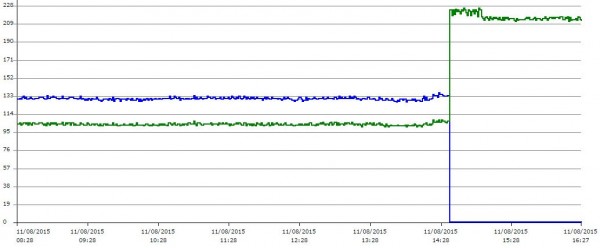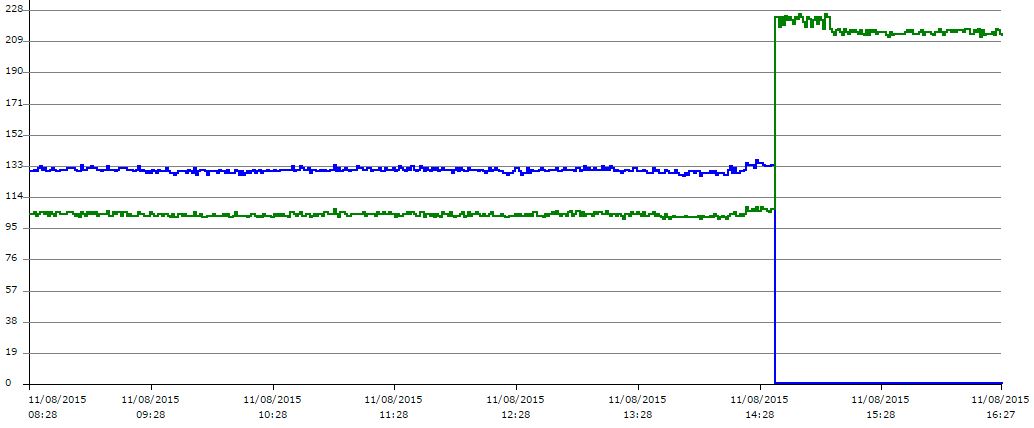One question we have received quite regularly is whether or not it is better to run with a single or dual power supplies. With the new STH datacenter lab we have the ability to monitor power consumption on a per-outlet basis. We wanted to show the impact of moving from one PSU to redundant power supplies and back as oftentimes servers are not tested explicitly stating whether one power supply or all power supplies were tested. As you will see, there is an impact depending on how the server is tested.
Test Configuration
We have a general purpose Windows virtualization server in the lab. We decided to test whether there was an impact of moving from redundant power supplies to a single power supply. Over the weekend, the Windows server has extremely low load so it was easy to test due to the server remaining in a steady idle state. The particular server is a Supermicro SuperServer 2028U-TR4+ with the following configuration:
- Dual Intel Xeon E5-2698 V3
- 258GB DDR4 RAM
- 5x 300GB 10K RPM SAS + 3 SAS SSDs
- 6x 960GB SATA SSDs
- Dual port 10Gb SFP+ (Intel X540 based) NIC
- LSI SAS 3108 1GB cache SAS controller
Perhaps most interesting is the redundant 1000W 80Plus Titanium power supplies which are some of the higher-end units one can get these days in terms of efficiency.
We are using a Schneider Electric / APC AP8441 PDUs in the datacenter with a 30A 208V power feed to each PDU. These are a particularly good fit for measuring datacenter equipment as there are more than a few colocation facilities that use these PDUs or similar APC products. We also “binned” our PDUs to ensure each outlet was reporting power +/- 0.1% of our Extech TrueRMS power meters. Unlike a normal installation, we wanted consistent power metering across all 24 outlets and in each rack. We ended up keeping 4 of the 10 PDUs we tested and returning the remainder as accuracy and consistency between ports are important to us. Afterall, what good is comparing power consumption across two outlets if they are 5% different.
Single or Redundant Power Supplies – Observations
We looked back at the log files over the previous 8 hours this Sunday morning. We are logging a sample every minute so there are a total of 480 data points on this graph. During the last two hours we were finishing up installing a new OpenStack node and decided to use our Windows server as a test case. The second power supply was disengaged and removed from operation. Luckily the first power supply was able to handle the load easily and the machine continued operating in its normal state. Here is what the graph looks like:

As one can see, the second power supply took up the load easily. We were seeing 40W more load on the machine’s second power supply so we caused the first power supply to more than double its output immediately. There was a short blip where the various alerts were triggered but then the machine went back into a steady state idle mode. Here are the key data points:
- Combined power with both power supplies active: 233w
- Combined power with one PSU installed and active: 213w
- Net single server idle power savings using one PSU: 20w
As one can see, the net impact even on extremely efficient 80Plus Titanium power supplies was an almost 10% lower total power draw. Today’s large servers often have power supplies that are at lower efficiency during idle (90% rather than 96% in their sweet spot.) Moving to one power supply increases the overall power efficiency of the system. 10%, of course, is not solely due to the power supply going down. On a titanium level power supply moving from 10% to 20% load on 208V we would expect an approximately 4% increase in efficiency. The additional power was saved likely due to not needing to cool the second power supply using its internal fan.
With the current reliability of server power supplies, this has a significant impact. For every 10 servers or so we could add another server into the rack (assuming we are power limited.) Our PDU ports cost us around $50 each ($1200/ 24 ports.) If one is not utilizing A+B power and instead is only using one power feed, there is a case to be made for only utilizing one power supply instead of two to increase overall system efficiency and lowering power delivery costs. This is especially true with lower power servers and today’s HA clustering techniques than can seamlessly handle in-place failures.
We have a number of these observations tested already but wanted to share an answer regarding a question we are asked quite often regarding the impact of moving from one power supply to two. Stay tuned for a bit more on what we are testing with datacenter power consumption and delivery.





Bravo on the read. We have never had a PSU fail but our VMware cluster wouldn’t sweat if 1 machine died. I might ask one of our rack monkeys to try this on a few of our Dells to test. I’ve always thought this might be better.
Hey this article is very good but I want to know this one. What is difference to 1U, 2U, 2-in-1s, 4-in-1s?
Patrick, Great article, has the numbers, graphs and explanation. Fabulous. Thank YOU
I’ve witnessed the same phenomena with mainstream rack servers like the DL380 and the IBM x3650. One supply is about 10% more efficient.
I’ve been looking into this as replacing one of the redundant power supplies with a battery. I know for example there are many supermicro systems which can have a battery module put in. This may also help with sizing the UPS required for a rack, essentially decentralising the majority of the power load.
Could you maybe test a power supply + battery setup and how these handle failure and the such?